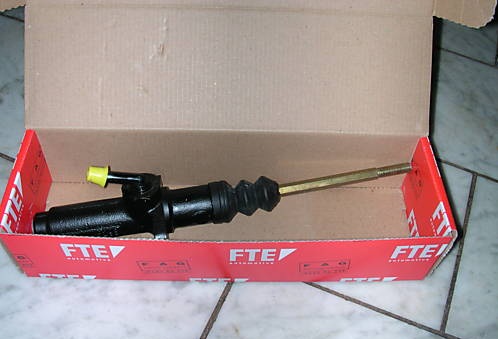

1) I used a pressure bleeder, a Blue Point BB-100A which I borrowed from a
retired Mercedes-Benz mechanic. A vacuum bleeder might do as well. I made sure I
bled the bleeder and I filled the adapter which screws onto the reservoir with
clean brake fluid with a little nozzle-bottle before I connected the hose from
the pressure bleeder. No need to inject still more air into the system.
2) I filled a clean jar of about 750 mL capacity with enough fresh brake fluid
to keep the end of the hose from the CSC submerged. I put a 7mm box-end wrench
on the bleed screw then a clean 1/8" vacuum/washer hose with some solder wrapped
around the far end to keep it weighed down. I arranged the hose so that the
weighted end will remain submerged in the fluid.
3) Pump up the bleeder and open the valve and the bleed screw on the CSC (Clutch
Slave Cylinder) and
observe that the fluid level rises in the jar, along with bubbles.
4) When the bubbling ceases, the line and CSC are now free of air, but because
of the near-vertical orientation of the CMC (Clutch Master Cylinder) it is likely still half full of air.
5) Grasp the clutch pedal with your hand and depress it slowly to the floor and
>leave it down<. Make sure it doesn't snap to the floor with the help of the
helper spring as this might rocket the hose out of the jar.
6) This forces the air from the CMC into the line. Note that even though the
pedal is down fluid continues to flow through the CMC as the piston seals are
effective in one direction only. Shortly, the bubbling in the jar will resume.
7) When the bubbling ceases, wait a little bit then lift the clutch pedal to the
fully engaged position. It is not necessary to close the bleed screw.
8) Any bubbling? If yes, wait until it stops. If no, again slowly depress the
pedal again. Any bubbling? Wait until it stops.
9) Lift the pedal slowly to the fully engaged position. After about another 200
mL has drained out, close the bleed screw and test the pedal for bounce (air
still present) and good 'feel' throughout its stroke. If necessary repeat steps
5 thru 8.
10) Disconnect the bleed hose, wipe the bleed screw and install the rubber cap.
11) Shut the valve on the pressure bleeder and disconnect. Wrap a towel around
the reservoir before you unscrew the adapter as there will be a big gush of
fluid which will damage paintwork.
12) Lower the 928 to the floor and start 'er up. Check that 1st and reverse
gears are easy to engage. Observe the smoke from the left exhaust manifold.
Nothing like the smell of burning brake fluid in the morning, smells like
victory...
jHh
1985 928S M5 Black
PS: I think the only thing I did that was different was leaving the pedal down
until the line is free of air.